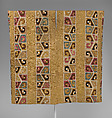Tapestry Tunic
The Andean region of South America was home to one of the longest, most complex textile histories in the world. Among the most spectacular traditions is that of the Wari Empire. From their highland capital near present-day Ayacucho, the Wari exerted strong cultural and political influence over southern coastal and highland regions of Peru. They introduced a distinctive art style, found on fine polychrome ceramics, exquisite personal ornaments crafted of precious materials, expertly carved works in wood, shell, and stone, and especially on elaborate textiles.
In the Precolumbian Andes, sleeveless tunics reaching to the knees and worn over a loincloth were the primary male garment. Tapestry-woven tunics were the most prestigious, and the finest examples were made of up to eighteen miles of handspun camelid wool. As with those of their successors, the Incas, Wari tunics are standardized in size, format, color, and design, suggesting they were produced in state-sponsored workshops. On this fine tunic, a wavelike motif known as a stepped fret is arranged in registers in vertical bands, separated by a white border. The precise significance of this motif is not known, but the dazzling interplay of harmonious colors—pink, magenta, turquoise, crimson, and brown, against a light brown background, creates a strikingly bold visual statement.
Due to rights restrictions, this image cannot be enlarged, viewed at full screen, or downloaded.
This artwork is meant to be viewed from right to left. Scroll left to view more.



